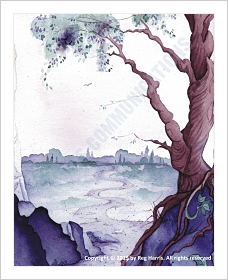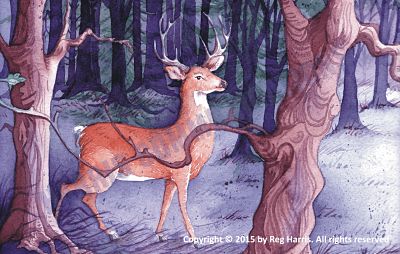Story shapes our lives and our worlds, and the Hero’s Journey is at the heart of story. It is both the process through which we build and rebuild our stories and the form of the stories themselves.
Several years ago when I rebuilt this website for the second time, I chose the fallow deer as a symbol to welcome readers to the new site. To launch this latest version of my site, I shall continue to use the fallow deer.
In Celtic mythology, a fallow deer leads the great Irish hero Oisin into the forest and to the edge of the western sea. There he meets Niamh (Nee-ev), the daughter of the god of the sea and one of the queens of Tiŕ na Nóg, the land of eternal youth. Oisin falls in love with Niamh and leaves his family and Ireland to return with her to Tiŕ na Nóg, where they marry.
There is no Niamh or Tiŕ na Nóg waiting in my site, but, nonetheless, I do hope to offer posts, articles and insights that will help you on your journeys, whether those journeys involve teaching, counseling or unfolding your own personal quest.

Your personal mythology…organizes your experiences and guides your actions. It is the lens through which you perceive the world. Its values and assumptions color all you see. – Feinstein & Krippner –
I used the Hero’s Journey in the classroom from 1975 until 2009, when I retired. It has been the focal point of my life since 1986. The most important thing I have learned in my studies is that we live in our stories. As Carol Pearson writes in The Hero Within,
Our experience quite literally is defined by our assumptions about life. We make stories about the world and to a large degree live out their plots. What our lives are like depends to a great extent on the script we consciously, or more likely, unconsciously, have adopted (1989, p. xxv).
Story shapes our lives and our worlds, and the Hero’s Journey is at the heart of story. It is both the process through which we build our stories and the form of the stories themselves. This storymaking is a natural function of our brain. “This is what our brain does all day long,” writes neurobiologist Michael Gazzaniga. “It takes input from other areas of our brain and from the environment and synthesizes it into a story.” We use story to organize experiences into a coherent and meaningful whole.
Because the Hero’s Journey is at the heart of story, it gives us a map to our personal narratives and a broader perspective through which we can understand and navigate our personal journeys. It also gives us a tool to help us heal or “redeem” an unsatisfying or troubling journey. “The individual has only to discover his own position with reference to this general human formula,” writes Joseph Campbell, “and let it then assist him past his restricting walls” (1949, p. 121). It’s this “power of perspective,” the potential the Hero’s Journey to help us place our experience in a greater context, that I will be exploring on this site.
So, join me in this exploration. I’ll be updating the site regularly, so come back often. But don’t just read and visit; be a part of the conversation. I welcome discussion and feedback: questions, comments, ideas, compliments and criticisms (how else do we grow?).
References
Campbell, J. (1949). The Hero with a Thousand Faces. Princeton, NJ: Princeton University.
Feinstein, D. & S. Krippner. (1997). They Mythic Path. New York: G. P. Putnam.
Gazzaniga, M. (2011). Who’s in charge?: Free will and the science of the brain. New York: Ecco/HarperCollins.
Pearson, C. (1989). The Hero Within: Six Archetypes We Live By (2nd ed.). NY: HarperCollins.
